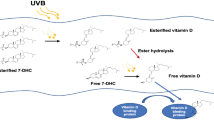Abstract
Vitamin D3 is generated in skin by UV irradiation of 7-dehydrocholesterol (7-DEHC). Whether the 7-DEHC amount in skin affects vitamin D3 formation, and thereby the plasma level of 25-hydroxyvitamin D3 (25[OH]D3) is not known. In the present work we report on the influence on vitamin D and Ca metabolism of a new hypocholesterolemic agent, HCG-917 (0-2-[hydroxy-3-]N′-(2-chlorophenyl)-N-piperazinyl-1-[propyl]-4-chloro-benz-aldoxim-hydrochloride) which inhibits 7-DEHC reductase and thereby increases skin 7-DEHC. Rats were treated with HCG 917 (0.3 and 5.0 mg/kg, orally) for 13 days. HCG 917 caused a dose-dependent decrease in cholesterol and concomitant accumulation of 7-DEHC in plasma and skin. In skin, 7-DEHC was: control: 1.05±0.20; HCG 917, 0.3 mg/kg: 1.41±0.22; HCG 917, 5.0 mg/kg: 2.35±0.35 mg/g. At a dose of 0.3 mg/kg, HCG 917 had no significant influence on the plasma level of neither 25(OH)D3 nor 1,25(OH)2D3. However, at a dose of 5.0 mg/kg, HCG 917 induced a significant increase in plasma 25(OH)D3 (control: 36.2±2.2; HCG 917 5.0 mg/kg: 57.6±6.5 nmol/l) and a slight but not significant rise in 1,25(OH)2D3. Calcium balance studies indicated that HCG 917 did not influence intestinal Ca absorption nor urinary Ca excretion. At a dose of 5.0 mg/kg HCG 917 slightly induced a decrease in total plasma Ca. In conclusion, HCG 917 treatment can induce a significant rise in skin 7-DEHC with an increase in plasma 25(OH)D3. These results suggest that variation in the skin level of 7-DEHC can directly influence the cutaneous production of vitamin D3 and thereby the vitamin D status of the organism.
Similar content being viewed by others
References
Bonjour JP, Trechsel U, Fleisch H, Schenk R, DeLuca HF, Baxter LA (1975) Action of 1,25-dihydroxyvitamin D3 and a diphosphonate on calcium metabolism in rats. Am J Physiol 229:402–408
Clemens TL, Adams JS, Horiuchi N, Gilchrest BA, Cho H, Tsuchiya Y, Matsuo N, Suda T, Holick MF (1983) Interaction of 1,25-dihydroxyvitamin D3 with keratinocytes and fibroblasts from skin of normal subjects and a subject with vitamin D-dependent rickets, type II: a model for study of the mode of action of 1,25-dihydroxyvitamin D3. J Clin Endocrinol Metab 56:824–830
Curtis HC, Burgi W (1966) Gaschromatographische Bestimmung des Serumcholesterins. Z Klin Chem 4:38–42
Eil C, Marx SJ (1981) Nuclear uptake of 1,25-dihydroxy[3H]-cholecalciferol in dispersed fibroblasts cultured from normal human skin. Proc Natl Acad Sci USA 78:2562–2566
Eisman JA, Hamstra AJ, Kream BE, DeLuca HF (1976) A sensitive, precise, and convenient method for determination of 1,25-dihydroxyvitamin D in human plasma. Arch Biochem Biophys 176:235–243
Esvelt RP, Schnoes HR, DeLuca HF (1978) Vitamin D3 from rat skins irradiated in vitro with ultraviolet light. Arch Biochem Biophys 188:282–286
Feldman D, Chen T, Hirst M, Colston K, Karasek M, Cone C (1980) Demonstration of 1,25-dihydroxyvitamin D3 receptor in human skin biopsies. J Clin Endocrinol Metab 51:1463–1465
Folch J, Lees M, Sloane-Stanley GH (1957) A simple method for the isolation and purification of total lipids from animal tissues. J Biol Chem 226:497–509
Fraser DR (1983) The physiological economy of vitamin D. Lancet i:969–972
Holick MF (1985) Vitamin D photobiology: Recent advances in the biochemistry and some clinical applications. In: Norman AW, Schaefer K, Grigoleit HG, Herrath DV (eds) Vitamin D, a chemical, biochemical and clinical update. de Gruyter, Berlin New York, pp 219–228
Holick MF, Clark MB (1978) The photobiogenesis and metabolism of vitamin D. Fed Proc 37:2567–2574
Holick MF, MacLaughlin JA, Clark MB, Holick SA, Potts JT Jr, Anderson RR, Blank IH, Parrish JA, Elias P (1980) Photosynthesis of previtamin D3 in human skin and the physiological consequences. Science 210:203–205
Lowry OH, Rosebrough NJ, Farr AL, Randall RJ (1951) Protein measurement with the Folin phenol reagent. J Biol Chem 193:265–275
Preece MA, O'Riordan JLH, Lawson DEM, Kodicek E (1974) A competitive protein-binding assay for 25-hydroxycholecalciferol and 25-hydroxyergocalciferol in serum. Clin Chim Acta 54:235–242
Simpson RU, DeLuca HF (1980) Characterization of a receptor-like protein for 1,25-dihydroxyvitamin D3 in rat skin. Proc Natl Acad Sci USA 77:5822–5826
Suda T, Miyaura C, Abe E, Kuroki T (1986) Modulation of cell differentiation, immune response and tumor promotion by vitamin D compounds. In: Peck WA (ed) Bone and mineral research 4. Elsevier, Amsterdam New York, pp 1–48
Trechsel U, Eisman JA, Fischer JA, Bonjour JP, Fleisch H (1980) Calcium-dependent, parathyroid hormone-independent regulation of 1,25-dihydroxyvitamin D. Am J Physiol 239: E119-E124
Author information
Authors and Affiliations
Rights and permissions
About this article
Cite this article
Bonjour, J.P., Trechsel, U., Granzer, E. et al. The increase in skin 7-dehydrocholesterol induced by an hypocholesterolemic agent is associated with elevated 25-hydroxyvitamin D3 plasma level. Pflugers Arch. 410, 165–168 (1987). https://doi.org/10.1007/BF00581910
Received:
Accepted:
Issue Date:
DOI: https://doi.org/10.1007/BF00581910




